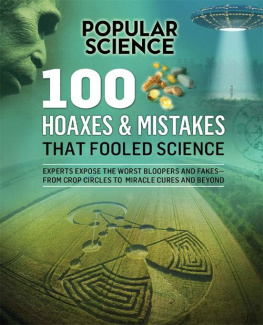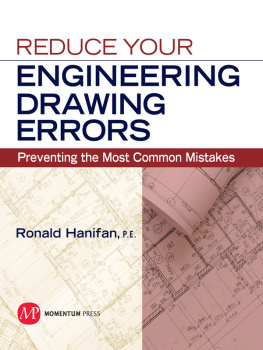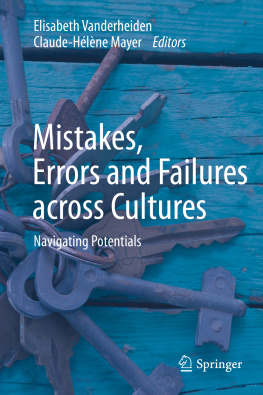Miscommunications
thinking|media
series editors:
bernd herzogenrath
patricia pisters
For Captain Pa (MK)
As ever, for Michelle and Chloe (TB)
Miscommunications
Errors, Mistakes, Media
Edited by
Maria Korolkova Timothy Barker
Contents
Figures
Photograph of mailman posing with child in his satchel |
Ghost Bridge/Replacement Bridge. |
James McIntosh Patrick, The Tay Bridge from My Studio Window (1948). |
Scanned pictures from the explorers photo album |
Illustrated pages from Etiopia journal |
Tom Thumb |
Computer game crashes |
Little Computer People |
Shannon(Weaver) mathematical model of communication. |
The War of the Ants module in action |
Table
Error Types with Examples from PASCAL (Top), C (Middle), and BASIC (Bottom) |
This volume is a delayed and largely rethought culmination of a seminar series Making Mistakes: Misleading and Misinterpreted Texts in Literature, Arts and History held at the University of Oxford in 201112. The series was conceptualized by the coeditor Maria Korolkova (then Pasholok) and Margarita Vaysman, and funded through the research grant of the Faculty of Medieval and Modern Languages. Maria is grateful to this funding body, all presenters, as well as to Clarendon Scholarship that sponsored her study at Oxford, and of course to Tim Barker for joining forces in reshaping these ideas into the current volume. Tims interest in errors and mistakes was first sparked by Mark Nunes, who many years ago included him in a special issue of M/C Journal and then later in the edited collection Errors: Glitch, Noise and Jam in Media Culture. Tim would like to thank Mark for publishing those early essays and of course to thank Maria for later reigniting his interest. Tim would also like to thank colleagues at the University of Glasgow for reading drafts and in general allowing him to talk to them about dialogue, agonism, and miscommunications. Thanks to Carl Lavery, Dimitris Eleftheriotis, and Michael Bachmann for the generosity with which they shared ideas.
Intellectual debts that Maria Korolkova has accumulated over the decade of rethinking the ideas expressed in this volume are multiple. She is in debt to Catriona Kelly for her intellectual, academic, and aesthetical guidance; to Margarita Vaysman for initial collaboration and the freedom to depart from the original directions of the seminars in developing this volume. It is an enormous pleasure to see Ellen Ruttens ideas on imperfection from the Mistakes seminar series developed and (im)perfected in the chapter to this volume. Maria is also grateful to Reidar Due for his many metaphysical intuitions back at Magdalen College. Beyond Oxford, gratitude goes to the colleagues from the Moscow State UniversityPavel Balditsynfor supporting her interest in Russian formalism in particular and critical thinking in general, late Natalia Chestnykh, for having inspired openness and creativity, and Dmitry Nesvetov, a source of endless philosophical discoveries.
University of Greenwich provided the intellectual forum for the coeditors of this volume to meet and launch this project, and they express their sincere gratitude to all involved. Steve Kennedys unconditional research support, and conversations at The Mitreon Michel Serres and the nature of chaoslet this project take its current shape, as well as his kindness to read the drafts of several chapters. Maria and Tim are also grateful to Maria Arche, who found time to comment on the linguistic side of miscommunications.
Sincere thanks are owed to all contributors to this volume.
Above all, Maria is grateful to her family Larisa, Mikhail, Nastasia, and Vasily for their support and love. And, as always, Tim owes it all to Michelle and Chloe.
Timothy Barker and Maria Korolkova
The most profound dialectical problem is not the problem of the Other, who is only a varietyor a variationof the Same, it is the problem of the third man. We might call this third man the demon, the prosopopoeia of noise.
Michel , Hermes: Literature,
Science, Philosophy, Baltimore and London:
John Hopkins University Press, 68
You should call it entropy, for two reasons. In the first place your uncertainty function has been used in statistical mechanics under that name, so it already has a name. In the second place, and more important, no one knows what entropy really is, so in a debate you will always have the advantage.
John Von Neuman to Claude Shannon,
cited in Tribus, Myron and McIrving,
Edward C. (), Energy and
Information, Scientific American , 225:
17988, 180
Fake news, misleading political slogans, interruptions to the flow of communication: these are not new phenomena, but they are ones that have started to become the most noticeable characteristic of media in the twenty-first century. To begin to think about this condition and explore the uncertainty produced by both purposefully and accidentally misleading communication, a good place to start is with two figures that have been instrumental in conceptualizing the role of noise in communication: one in the field of engineering and one in the field of philosophy. Claude Shannon was working on his now famous mathematical theory of information when he was looking for a way to describe the uncertainty of information that equates to noise. Taking his lead from John Von Neuman, Shannon described this function as entropy (a word that, as Von Neuman points out, is surrounded by its own share of uncertainty). Shannon uses the language of thermodynamic, which explains how energy is lost as heat, to describe the way information can be lost as noise. This shift in thinking signified nothing less than a new way to conceive communication systems in terms of the levels of uncertainty that they are capable of dealing with. It also signified an important concept that can be used in coming to grips with the new political realities of noise.
Shifting this technical description into the field of philosophy, Michel Serres uses Shannon but gives us something altogether more radical. Serres tells us that any philosophy of communicative realities need not start from the attempt to uncover dialectic relationship between sender and receiver but should completely refocus attention on Shannons uncertainty function and the way that communication functions as the sender and receiver are united in a battle against noise. Any model of communication, for Serres, always involves three parties: the sender, the receiver, and a third that seeks to interrupt communication and to introduce what we could call a miscommunication.
Serres asks, how does one enter into communication with another? The answer that he offers is that for information to be transmitted and to take on meaning it necessitates noise; it is only via its differentiation from noise that information is able to exist at all. For communication to take place, it needs to paradoxically exclude that which it necessitates (Harari and Bell in conditions. They combine to both offer and interrogate a new philosophy of media and a new approach to studying communication with the concept of the mistake, of errant communication, and of noise at its center. To set up the chapters that come, in this introduction we outline a number of pillars that support this mode of enquiry. First, we set out some existing definitions of miscommunication and indicate how this collection both builds on and then moves beyond these approaches. Second, we compare the notion of the error and the accident in the writing of Umberto Eco, Victor Shklovsky, and Paul Virilio, exploring the relationship of language, codes, and mistakes to humanness and creativity. Thirdly, we outline a model of miscommunication based on the breakdowns in the transmission of messages, mostly developed through our use of Serres description of the figures of parasites, the Ancient Greek messenger Hermes, and fallen angels.








